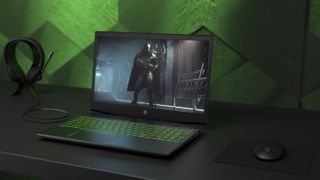The cheapest laptop could now challenge the PS5 and Xbox Series X thanks to GeForce Now
Nvidia’s streaming tech could be a big game changer

GeForce Now could be a genuinely disruptive technology in the gaming war. By using Nvidia’s remote streaming technology, you can use the internet to remotely access a powerful gaming PC and run the very latest games – and rather than the power of your hardware determining your gaming experience, it’s the quality of your internet connection.
Basically, it means you could buy the cheapest Windows 10 laptop that can run the GeForce Now app, and you should be able to play games that normally would require hugely expensive hardware to run.
Take a look at the minimum specification you need to run GeForce Now:
- Windows 7 64-bit or above
- Dual core x86-64 CPU with 2.0GHz or faster
- 4GB of system memory
- GPU that at least supports DirectX 11
The only thing that’s a bit demanding is the fact you need a 64-bit operating system, and a DirectX 11 GPU. However, on the GPU front, integrated Intel HD Graphics 2000 graphics are supported, which means laptops from the past few years will meet these specs.
Compare that to the minimum specifications for Wolfenstein II: The New Colossus, which can be played via GeForce Now:
- Intel Core i7-3770/AMD FX-8350 or better CPU
- 8GB RAM
- Nvidia GTX 770 4GB/AMD Radeon R9 290 4GB or better GPU
That’s a huge difference in requirements – and if you go for the recommended specs, the gap is even wider.
Another thing to note is that if you want to play Wolfenstein II: The New Colossus locally, you also need 55GB of storage. On old and cheap laptops, that’s a huge amount. With GeForce Now, the game is installed remotely, so you only need to download and install the GeForce Now client – which is 70MB.
Get daily insight, inspiration and deals in your inbox
Get the hottest deals available in your inbox plus news, reviews, opinion, analysis and more from the TechRadar team.
Why buy an expensive gaming laptop?
The hardware of the remote PCs you connect to via GeForce Now are powerful enough to play games at high graphical settings – and if you go for the Founder’s subscription ($4.99 a month), you get ray tracing support as well – something only the latest (and most expensive) GPUs can usually handle.
In theory, then, for $4.99 a month and a cheap laptop, you could have a gaming device that would seriously challenge the PS5 and Xbox Series X.
That’s a seriously exciting proposition.
So, does it work? I’ve been playing the aforementioned Wolfenstein II on a laptop from a few years ago, with an aging 7th gen Intel processor and only integrated graphics. While it’s still an OK laptop for word processing and web browsing, it certainly not usually capable of playing games – especially graphically-demanding title like Wolfenstein II.

This is using a Wi-Fi connection as well, certainly not optimal conditions for streaming a game. And while it didn’t feel as immediate and responsive as playing the game locally, I was mightily impressed.
The fact that you can also run GeForce Now on Mac means that owners of Apple’s PCs can finally play previously Windows-only games. Thanks to GeForce Now, you may no longer have to miss out on some of the best PC games ever just because you’re using a MacBook.
I actually played PlayerUnknown’s Battlegrounds on a MacBook in the beta version of GeForce Now, and again I was impressed – especially as this was a game you shouldn’t be able to play on a MacBook.
So, does GeForce Now mean I’ll never buy another GPU, gaming laptop or games console again? Well, I don’t think I’ll ever stop gaming on a desktop PC. I love having a powerful machine that can play games at 4K resolutions without worrying about my internet speeds or paying a subscription.

But I’ve never been truly sold on a gaming laptop. They are either too big and bulky, or simply too expensive, with hardware that will go out of date, and won’t be easily upgradable (unlike with desktop PCs). Plus, the less said about their paltry battery lives, the better.
GeForce Now has the potential to address many of these complaints. Because Nvidia is looking after the remote hardware, I’m sure it will keep the PCs powering games on the service updated.
And, because you’re streaming the game, rather than playing it locally, it means your laptop isn’t working so hard – and therefore battery life is much longer.
But what about the PS5 and Xbox Series X? I’ll probably still get a PS5 in the future – after all, no matter how good GeForce Now is, Sony’s exclusives won’t be on the service. And there’s no way I’m missing out on Last of Us 2 and the next Uncharted.
As for the Xbox Series X – if all the games Microsoft is making for its next gen console are also going to arrive on PC – and likely GeForce Now (especially if they are also on Steam), then why would I want to pay the Xbox Series X price when I could just stream to my existing Nvidia Shield console – which also supports GeForce Now?
Not long ago, Microsoft’s Phil Spencer said that Google and Amazon were Xbox’s chief competitors now, not Sony and Nintendo. I think Microsoft should now be more worried about Nvidia.
- These are the best gaming laptops of 2020

Matt is TechRadar's Managing Editor for Core Tech, looking after computing and mobile technology. Having written for a number of publications such as PC Plus, PC Format, T3 and Linux Format, there's no aspect of technology that Matt isn't passionate about, especially computing and PC gaming. Ever since he got an Amiga A500+ for Christmas in 1991, he's loved using (and playing on) computers, and will talk endlessly about how The Secret of Monkey Island is the best game ever made.
